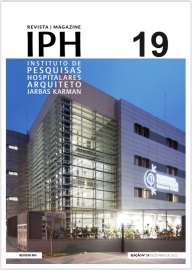Publications IPH Magazine Magazine IPH Nº19 Editorial Magazine IPH Nº19

- Editorial Magazine IPH Nº19
- From Hospital Architecture to Architecture for Health
- Design for health environments: how neuroscience applied to architecture can contribute to the health and well-being of its users
- Jarbas Karmans experience during his SESP Years
- Evolution of hospital building, its alignment with medical sciences and patient care in the city of São Paulo
It is with a high note, with the publication of this new edition of IPH Magazine, that we end a very important year for the technical-scientific community that is interested in research applied to the healthcare settings and infrastructure.
In 2022 we have observed a gradual return to a more normal situation, both regarding institutional partnerships and collaborations, as well as in field research initiatives, which were impaired or even disabled due to the Covid-19 pandemic and other challenges related to the production of scientific knowledge in Brazil. This was also a year of many debates and reflections on architecture and healthcare engineering, and we have observed a growing interest in both the production and dissemination of research in various formats and subjects.
This edition of the IPH Magazine includes an article that deals with a very current theme, that has aroused scientific and professional interest,which is the appropriation, by architects and designers of health settings,of concepts based on Neuroscience, the branch of biology that studies the nervous system. In her article, the architect and researcher Patrícia Paiva shows how neuroscience applied to the architecture can contribute to the health and well-being of users of healthcare settings, including patients, companions, and workers. According to the author?s words ?the stimulation of the senses, via access to our nervous system, through
vision, smell, hearing, taste and touch? can create a positive or negative impact on people?s quality of life. From this finding, the author proposes a series of reflections on how the built environment affects people and exemplifies the application of environmental strategies that stimulate the senses, such as biophilic design, natural lighting and acoustic comfort.
In an opinion piece, the architect and professor Luciano Monza brings a reflection about the paradigms involved in the conception and the operation of health buildings. According to Monza, who works with health projects in Argentina, the transformations that occurred in the models and the process of the disease/care, in technological development and in the alteration of the epidemiological profiles, among others, caused the appearance and development of new constructive typologies, where the traditional concept of hospital architecture was abandoned.
Monza points out that the general hospital is no longer the paradigmatic building of health, as it was historically until the second or late twentieth century, and that it continues to occupy an important place, but no longer exclusive, as an object of study. According to the author, other constructive typologies have appeared and, most likely, will grow even more in quantity and variety in the future. In another article, the researchers Regiane Lamim and Isabel Céspedes present a historical overview of health buildings in the city of São Paulo, seeking to draw a parallel between the evolution of medical sciences and architecture. According to the authors, the development of medical sciences led to the adoption of the ?pavilion? typology in hospital buildings in the 19th century, moving to the ?monobloc? typology in the 20th century, when the hospital came to be considered as a ?healing machine?, also arguing that knowing this historical evolution is fundamental to predict the parameters for the future of hospitals.
Finally, professor and researcher Erick Vicente presents a text about the experience of the late Architect Jarbas Karman, founder of IPH, during his stint at the Special Public Health Service (SESP), highlighting the importance of this experience as a public servant for the trajectory of Karman and other architects who worked on that public body and who later made important contributions to the development of hospital architecture in Brazil. The author exemplifies the production of this period with a brief analysis of two projects developed by Karman for SESP in the state of Pará.
The IPH Magazine remains available for free to the whole Community of professionals, researchers and others interested in topics related to healthcare settings and infrastructure, seeking to recognize the value of the diversity of themes and approaches, and opening an opportunity for all interested parties in sharing their studies and experiences, with a renewed invitation to submit your contributions to the next editions.
Good reading!
Prof. Arch. Marcio Nascimento de Oliveira
Editor of IPH Magazine


